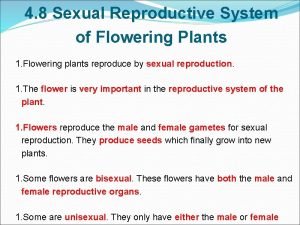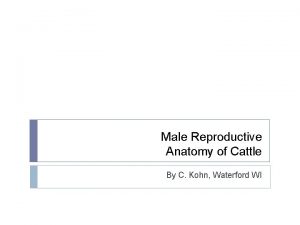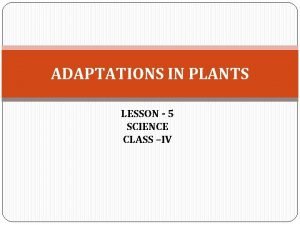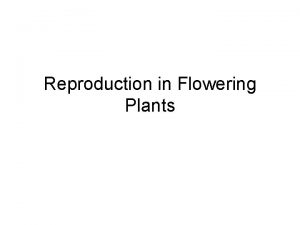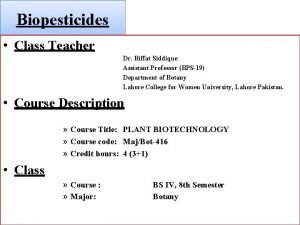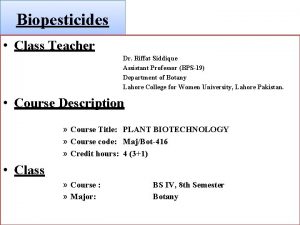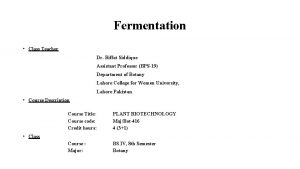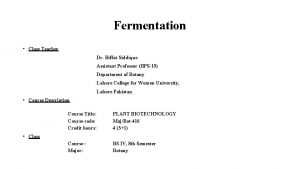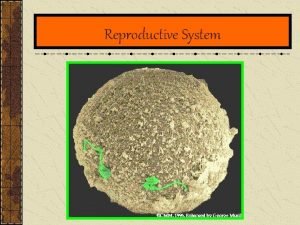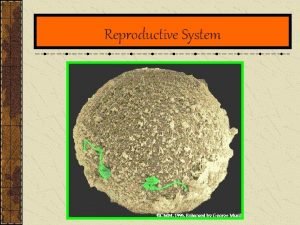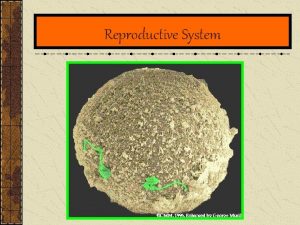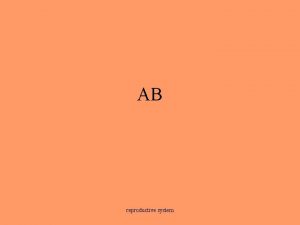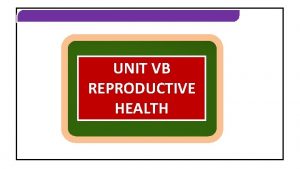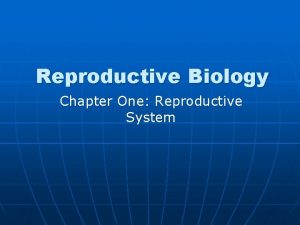Reproductive Parts of Plants Class Teacher Dr Riffat



















- Slides: 19

• Reproductive Parts of Plants • Class Teacher Dr. Riffat Siddique Assistant Professor (BPS-19) Department of Botany Lahore College for Women University, Lahore, Pakistan • Course Description Course Title: PLANT ANATOMY • Course code: Maj/Bot-306 Credit hours: 4 (3+1) Class Course : BS III, 6 th Semester Major: Botany

Reproductive Parts of Plants Seed: Seeds are the dispersal and propagation units of most plants. Flower: A flower, sometimes known as a bloom or blossom, is the reproductive structure found in flowering plants. The biological function of a flower is to effect reproduction, usually by providing a mechanism for the union of sperm with eggs. Flowers may facilitate outcrossing or allow selfing. Fruit: fruit is the seed-bearing structure in flowering plants formed from the ovary after flowering. Fruits are the means by which angiosperms disseminate seeds.

Anatomy of Flower Peduncle: This is the stalk of the flower. Receptacle: It is that part of the flower to which the stalk is attached to. It is small and found at the center of the base of the flower. Sepals: These are the small, leaf-like parts growing at the base of the petals. They form the outermost whorl of the flower. Collectively, sepals are known as the calyx. The main function of the calyx and its sepals is to protect the flower before it blossoms(in the bud stage). Petals: This layer lies just above the sepal layer. They are often bright in colour as their main function is to attract pollinators such as insects, butterflies etc to the flower. The petals are collectively known as the corolla. Stamens: These are the male parts of a flower. Many stamens are collectively known as the androecium. They are structurally divided into two parts:

Filament: The part that is long and slender and attached the anther to the flower. Anthers: It is the head of the stamen and is responsible for producing the pollen which is transferred to the pistil or female parts of the same or another flower to bring about fertilization. Pistil: This forms the female parts of a flower. A collection of pistils is called the gynoecium.

Pistil consists of four parts Style : is a long slender stalk that holds the stigma. Once the pollen reaches the stigma, the style starts to become hollow and forms a tube called the pollen tube which takes the pollen to the ovaries to enable fertilization. Stigma: . This is found at the tip of the style. It forms the head of the pistil. The stigma contains a sticky substance whose job is to catch pollen grains from different pollinators or those dispersed through the wind. They are responsible to begin the process of fertilization Ovary : They form the base of the pistil. The ovary holds the ovules. Ovules: These are the egg cells of a flower. They are contained in the ovary. In the event of a favorable pollination where a compatible pollen reaches the stigma and eventually reaches the ovary to fuse with the ovules, this fertilized product forms the fruit and the ovules become the seeds of the fruit.

Anatomy of Seeds are the dispersal and propagation units of the Spermatophyta (seed plants): Gymnosperms (conifers and related clades) and Angiosperms (flowering plants). Seeds are mature, fertilized ovules. Ovules are structures of seed plants containing the female gametophyte with the egg cell, all being surrounded by the nucellus and 1 -2 integuments. In angiosperms the double fertilization results in formation of the diploid embryo and the triploid endosperm. Embryo: Young sporophyt, dipoid (2 n), result of fertilization. The mature embryo consists of cotyledons (seed leaves), hypocotyl (stem-like embryonic axis below the cotyledons), radicle (embryonic root).

Anatomy of Seed Plumule The plumule is the embryonic shoot. In it two or more leaves are usually visible, with a growing point enclosed between them. Hypocotyl The part of a plant embryo or seedling plant that is between the cotyledons and the radicle or root. In a seedling it is the sprout structure above ground that supports the Cotyledon (first leaves). Radicle (Tap Root) The radicle is the embryonic root which grows and develops into the root system of the plant. Epicotyl The epicotyl is the embryonic shoot above the cotyledons. In most plants the epicotyl will eventually develop into the leaves of the plant. In dicots, the hypocotyl is what appears to be the base stem under the spent withered cotyledons, and the shoot just above that is the epicotyl. Source: http: //www. seedbiology. de/structure. asp

Cotyledon The grasses and narrow-leaved plants like the iris and bluebell have seeds with only one cotyledon. The other flowering plants all have two cotyledons. They are leaves attached to the plumule and radicle by short stalks, and they often contain food reserves which are used during the early stages of germination. In most plants the cotyledons are brought out of the testa and above the ground where they become green and make food by photosynthesis. The cotyledons eventually fall off, usually after the first foliage leaves have been formed. The cotyledon leaves bear no resemblance to the foliage leaf, the shape of which is first apparent when the plumule leaves open and grow. Source: http: //www. seedbiology. de/structure. asp https: //www. google. com/search? q=hilum+and+micropyle+ppt&tbm=isch&ved=2 ah. UKEwi. Op. P Kil 6 Dp. Ah. UJKho. KHe 8_CDQQ 2 c. Ceg. QIABAA&oq=hilum+and+micropyle+ppt&gs_lcp=Cg. Npb. Wc. QA 1 C 8 s. BVYxe. EVYPjj. FWg. A c. AB 4 AIABAIg. BAJIBAJg. BAa. ABAao. BC 2 d 3 cy 13 a. Xota. W 1 n&sclient=img&ei=JSyz. Xs 79 E 4 n. Ua. O __o. KAD&bih=657&biw=1366&safe=active&hl=en#imgrc=3 Cge 11 Q 5 zox. ZSM

Seed Coat (Testa) A tough, hard, outer coat, the testa protects the seed from fungi, bacteria and insects. It has to be split open by the radicle before germination can proceed. It developed from the integuments of the ovule, diploid maternal tissue. The testa also has two anatomical features that might be a little harder to identify: i. Hilum: The hilum is a scar left by the stalk which attached the ovule to the ovary wall. ii. Micropyle: The Micropyle is a canal or hole in the coverings (seed coat) of the nucellus through which the pollen tube usually passes during fertilization. Later, when the seed matures and starts to germinate, the micropyle serves as a minute pore through which water enters. The micropylar seed end has been demonstrated to be the major entry point for water during tobacco seed imbibition and germination. During germination the tobacco testa ruptures at the micropylar end and the radicle protrudes through the micropylar endosperm


Endosperm: Food storage tissue, triploid (3 n), result of double fertilization, 2/3 of the genome is of maternal origin. Perisperm: Diploid maternal food storage tissue originates from the nucellus. Only in some species, e. g. Beta vulgaris, Piper nigrum, Coffea arabica, many Caryophyllales. Endospermic seeds: The endosperm is present in the mature seed and serves as food storage organ. Testa and endosperm are the two covering layers of the embryo. The amount of endosperm in mature seeds is highly species-dependent and varies from an abundant endosperm layer (Nicotiana tabaccum) to a single layer (Arabidopsis thaliana). Non-endospermic seeds: The cotyledons serve as sole food storage organs as in the case of pea (Pisum sativum). During embryo development the cotyledons absorb the food reserves from the endosperm. The endosperm is almost degraded in the mature seed and the embryo is enclosed by the testa.

Endospermic and Non-endospermic seeds Source: https: //slideplayer. c om/slide/5661383/

Chalaza: Non-micropylar end of the seed. The base of an ovule, bearing an embryo sac surrounded by integuments. Located opposite to micropyler end. Raphe: Ridge on seed coat formed from adnate funiculus. Aril: Outgrowth of funiculus, raphe, or integuments; or fleshy integuments or seed coat, a sarcotesta. Arils probably often aid seed dispersal, by drawing attention to the seed after the fruit has dehisced, and by providing food as an attractant reward to the disperser. The red flesh surrounding each pomegranate seed is an edible aril, as is the white flesh of ackee, lychee. Strophiole: Outgrowth of the hilum region which restricts water movement into and out of some seeds. In some hard-coated legume seeds, e. g. Melilotus alba and Trigonella arabica, a plug covering a special opening - the strophiolar cleft - must be loosened or removed before water can enter, and then only through this region. Operculum: A little seed lid. It refers to a dehiscent cap of a seed or a fruit that opens during germination. Carunculate: Seed with an excrescent outgrowth from integuments near the hilum, as in Euphorbia. Fibrous: Seed with stringy or cord-like seed coat, as mace in Myristica.

Fibrous

Source: https: //www. britannica. com/science/aril https: //www. flickr. com/photos/ophis/3234997141 Arillate

Anatomy Of Fruit • Fruits are mature ovary and ovaries of one and more flowers. • Its primary function is to distribute seeds to new areas where the plant might grow ( seed dispersal vehicle ) Structure: A fruit is composed of the pericarp and the seeds. STRUCTURE OF PERICARP: In fruits outer layer is the pericarp which is the tissue that develops from the ovary wall of flowers and surrounds the seed.

Layers of pericarp 1. Epicarpic / exocarpic: Outermost layer of the pericarp, form the tough outer skin of the fruit, if there is one. Pericarp sometimes called exocarp, especially in Citrus, the flavedo. Flavedo: It is mostly composed of cellulosic material but also contain other components, such as essential oils, steroids, fatty acids, pigments, enzymes etc. In Citrus fruits, the flavedo constitutes the peripheral surface of the pericarp.

Mesocarp: It is the fleshy middle layer of the pericarp of a fruit; it is found between epicarp and endocarp. It is eatable part of fruit. It may also refere to any fruit that is fleshy throughout. EXAMPLES: Edible part of Peach , Tomato. In hesperidium, as is found in citrus fruit, the mesocarp is also referred as albedo or pith. 3. Endocarp: It is the inside layer of the pericarp, which directly surrounds the seeds. It may be membranous as in citrus or thick and hard in stone fruits of the family Rosaceae such as Peaches, Apricots etc. In Nuts, it is the stony layer that surrounds the kernel of walnuts etc. and that is removed prior to consumption. In Citrus fruits, the endocarp is separated into sections, which are called segments. These segments are filled with Juice vesicles, which contain the juice of the fruit.

Source: https: //favpng. com/png_view/fruit-anatomy-lime-oplodie-egzokarpgrape-berry-png/siu 0 Er. Hj
 Reproduction system of plants
Reproduction system of plants Examples of asexual reproduction
Examples of asexual reproduction Male plant reproductive system
Male plant reproductive system Vascular plants vs nonvascular plants
Vascular plants vs nonvascular plants Non vascular plants
Non vascular plants Classification of non flowering plants
Classification of non flowering plants C3 plants vs c4 plants
C3 plants vs c4 plants Inferior or superior ovary
Inferior or superior ovary Parts of and functions of female reproductive system
Parts of and functions of female reproductive system What is reproductive system
What is reproductive system The reproductive system chapter 16
The reproductive system chapter 16 Bull reproductive system parts and functions
Bull reproductive system parts and functions Cow reproduction system
Cow reproduction system Parts of flower
Parts of flower What part of the plant produces pollen
What part of the plant produces pollen Ma equivalent
Ma equivalent Good afternoon students
Good afternoon students Objectives of photosynthesis
Objectives of photosynthesis Adaptation of fixed plants
Adaptation of fixed plants What part of the plant produces pollen
What part of the plant produces pollen


